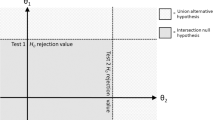Summary
Alternative methods for partitioning the genotype-by-environment interaction, for an arbitrary number of genotypes or environments, were examined. Partitioning of the interaction is important in order to determine the nature of the interaction. Two methods of partitioning were examined; both separated the interaction into two types: (1) due to heterogeneous variances or (2) due to imperfect correlations. Method 1 was based on heterogeneity among environments in the scaling of differences among genotypes. Method 2 was based on heterogeneity among genotypes in the scaling of differences among environments. Any remaining interaction arises from deviations from the perfect positive correlation of genotypic rankings among environments (Method 1) or of environmental rankings among genotypes (Method 2). Method 1 is more appropriate for random genotypes that are to be tested in either fixed or random environments. With Method 1, the interactions that arise mainly from heterogeneity of genotypic scaling among environments are generally unimportant. However, if environments are fixed and interactions are mainly due to imperfect correlations of rankings, specialized lines may be indicated for each environment. Method 2 is more useful in evaluating fixed genotypes for sensitivity to random environments. A partitioning of the interaction into that due to the type of interaction within each genotype was shown to be useful in that situation.
Similar content being viewed by others
References
Abou-El-Fittouh HA, Rawlings JO, Miller PA (1969) Classification of environments to control genotype by environment interactions with an application to cotton. Crop Sci 9:135–140
Casella G, Berger RL (1990) Statistical inference, Wadsworth and Brooks/Cole, Pacific Grove, Calif.
Cockerham CC (1963) Estimation of genetic variances. In: Hanson WD, Robinson HF (eds) Statistical genetics and plant breeding. NAS-NRC, Washington, D.C., pp 53–94
Dickerson GE (1962) Implications of genetic-environmental interaction in animal breeding. Anim Prod 4:47–63
Dowson DC, Landau BV (1982) The Fréchet distance between multivariate normal distributions. J Multivar Anal 12:450–455
Eisen EJ, Saxton AM (1983) Genotype by environment interactions and genetic correlations involving two environmental factors. Theor Appl Genet 67:75–86
Finlay KW, Wilkinson GN (1963) The analysis of adaptation in a plant-breeding programme. Aust J Agric Res 14:742–754
Freeman GH (1973) Statistical methods for the analysis of genotype-environment interactions. Heredity 31:339–354
Kang MS (1990) (ed) Genotype-by-environment interaction and plant breeding. Department of Agronomy, Louisiana Agricultural Experiment Station, Louisiana State University Agricultural Center, Baton Rouge, LA 70803–2110
Lefkovitch LP (1985) Multi-criteria clustering in genotype-environment interaction problems. Theor Appl Genet 70:585–589
Lin CS, Butler G (1990) Cluster analyses for analyzing two-way classification data. Agron J 82:344–348
Lin CS, Binns MR, Lefkovitch LP (1986) Stability analysis: Where do we stand? Crop Sci 26:894–900
Muir WM (1986) Relative efficiency of selection for performance of birds housed in colony cages based on production in single bird cages. Poult Sci 64:2239–2247
Moll RH, Cockerham CC, Stuber CW, Williams WP (1978) Selection responses, genetic-environmental interactions, and heterosis with recurrent selection for yield in maize. Crop Sci 18:641–645
Mooers CA (1921) The agronomic placement of varieties. J Am Soc Agron 13:337–352
Robertson A (1959) The sampling variance of the genetic correlation coefficient. Biometrics 15:469–485
Wricke G (1962) Über eine Methode zur Erfassung der ökologischen Streubreite in Feldversuchen. Z Pflanzenzucht 47:92–96
Yamada Y (1962) Genotype by environment interaction and genetic correlation of the same trait under different environments. Jpn J Genet 37:498–509
Yamada Y, Itoh Y, Sugimoto I (1988) Parametric relationships between genotype x environment interaction and genetic correlation when two environments are involved. Theor Appl Genet 76:850–854
Yates F, Cochran WG (1938) The analysis of groups of experiments. J Agric Sci 28:556–580
Author information
Authors and Affiliations
Additional information
Communicated by L. D. Van Vleck
Journal Paper No. 123737 of the Purdue University Agricultural Experiment Station
Rights and permissions
About this article
Cite this article
Muir, W., Nyquist, W.E. & Xu, S. Alternative partitioning of the genotype-by-environment interaction. Theoret. Appl. Genetics 84, 193–200 (1992). https://doi.org/10.1007/BF00224000
Received:
Accepted:
Issue Date:
DOI: https://doi.org/10.1007/BF00224000




